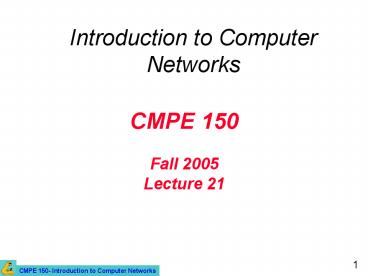CMPE 150 Fall 2005 Lecture 21 - PowerPoint PPT Presentation
1 / 23
Title:
CMPE 150 Fall 2005 Lecture 21
Description:
General statement about optimal routes (topology, routing algorithm independent) ... Algorithms vary on how they get routing information, metrics used, and when they ... – PowerPoint PPT presentation
Number of Views:52
Avg rating:3.0/5.0
Title: CMPE 150 Fall 2005 Lecture 21
1
CMPE 150 Fall 2005Lecture 21
- Introduction to Computer Networks
2
Announcements
- Homework 4 up.
- Due on 11.23.05.
- Lab this week
- The Internet Behind the Web video.
3
Today
- Finish DLL!
4
Last Class
- Network Layer.
- Focus on packet switching networks.
- Main functions.
- Different network layer implementations.
- Datagrams versus virtual circuits.
5
Virtual-Circuit versus Datagram Subnets
5-4
6
Routing
7
Routing
- One of the main functions of network layer.
- Routing versus forwarding?
- Datagram versus VC networks?
8
Routing Algorithm
- Computes routing tables.
- Properties
- Correctness.
- Robustness.
- Stability.
- Optimality.
- Try to optimize a certain metric.
9
Optimality Principle
- General statement about optimal routes (topology,
routing algorithm independent). - If router J is on optimal path between I and K,
then the optimal path from J to K also falls
along the same route. - Proof by contradiction.
- Corollary
- Set of optimal routes from all sources to
destination form a tree rooted at destination. - Sink tree.
10
Types of Routing Algorithms
- Non-adaptive versus adaptive.
11
Adaptive and Non-adaptive Routing
- Non-adaptive routing
- Fixed routing, static routing.
- Do not take current state of the network (e.g.,
load, topology). - Routes are computed in advance, off-line, and
downloaded to routers when booted. - Adaptive routing
- Routes change dynamically as function of current
state of network. - Algorithms vary on how they get routing
information, metrics used, and when they change
routes.
12
Static Algorithms
- (Non-Adaptive)
- Shortest-path routing.
- Flooding.
13
Shortest-Path Routing
- Problem Given a graph, where nodes represent
routers and edges, links, find shortest path
between a given pair of nodes. - What is shortest in shortest path?
- Depends on the routing metric in use.
- Example number of hops (static), geographic
distance (static), delay, bandwidth (raw versus
available), combination of a subset of these. - Dijkstras shortest-path algorithm (19590.
14
Dijkstras Shortest-Path Algorithm
- Initially, links are assigned costs.
- As the algorithm executes, nodes are labeled with
its distance to source along best known path. - Initially, no routes known, so all nodes are
labeled with infinity. - Labels change as the algorithm proceeds.
- Labels can be temporary or permanent.
- Initially all labels are tentative.
- A label becomes permanent if it represents the
shortest path from the source to the node.
15
Shortest Path Routing
Find shortest-path from A to D
Label each adjacent node with
distance to A.
Start
B is made permanent.
16
Flooding
- Every incoming packet forwarded on every outgoing
link except the one it arrived on. - Problem duplicates.
- Constraining the flood
- Hop count.
- Keep track of packets that have been flooded.
- Robust, shortest delay (picks shortest path as
one of the paths).
17
Flooding Example
- Stallings Figure 12.4
- (hop-count3)
18
Dynamic Routing Algorithms
- (Adaptive Routing)
- Distance vector routing.
- Link state routing.
19
Distance Vector Routing
- Aka, Bellman-Ford (1957), Ford-Fulkerson (1962).
- Original ARPANET routing also used by Internets
RIP. - Each router keeps routing table (or routing
vector) with best known distance to each
destination and corresponding outgoing interface. - Routing tables are updated by exchanging routing
information with neighbors.
20
Distance Vector (Contd)
- Routing table at each router
- One entry per participating router.
- Each entry contains outgoing interface and
distance to corresponding destination. - Metric number of hops, delay, queue length.
- Each router knows distance to its neighbors.
- Old ARPANET algorithm DV where cost metric is
outgoing link queue length.
21
Distance Vector Routing
- (a) A subnet. (b) Input from A, I, H, K, and the
new routing table for J.
22
Routing Updates
- Every T interval, routers exchange routing
updates. - Routing update from router X consists of a vector
with all destinations and the corresponding
distance from X to them. - When router Y receives an update from X, it can
estimate its distance to router Z through X as
Dyz Dyx Dxz. - Router Y receives update from all its neighbors
and builds a new RT.
23
Distance Vector Example
3
2
3
3
5
2
2 3 4
Node Distance Next
9
1
1
2
1
0 -
3
7
5
6
1
0
1
2 2 2
2
7
4
2
9
5
4
3 5 3
3
0
2
Node Distance Next
4 1 4
2
2
0
1
0 -
5 6 3
3
1
1
2 2 2
5
3
3
6 8 3
3 3 4
TT1
TT0
4 1 4
TT2
5 2 4
6 4 4































